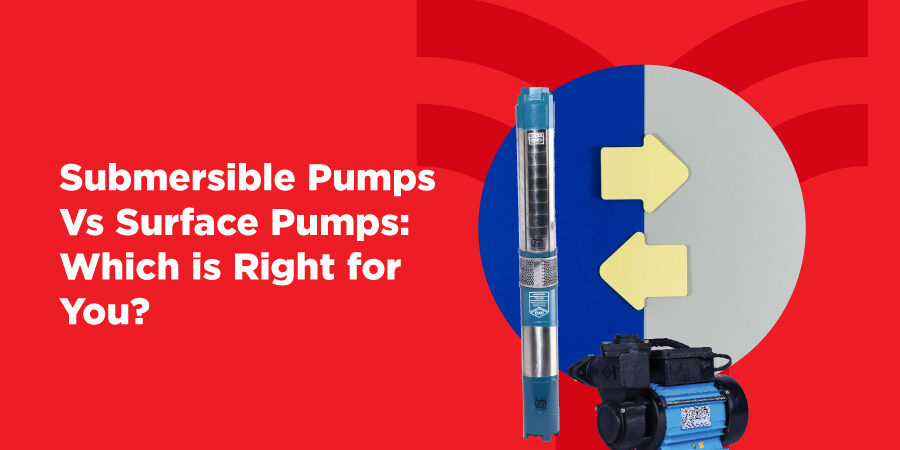Submersible Pumps vs. Surface Pumps: Which is Best for Your Requirements?
Water pumps are essential to many sectors of the economy, including wastewater treatment, home water supply, agriculture, and construction. Submersible pumps and surface pumps are the two primary types to consider when choosing the best pump for your requirements. Although they each have important functions, their designs, functions, and applications differ significantly. Comprehending these distinctions will enable you to select the ideal pump for your particular needs in an informed manner.
What are Submersible Pumps?
Submersible pumps are designed to work when completely immersed in the fluid they are pumping. Because of their waterproof housing, these pumps are shielded against water damage to the motor and internal parts. Submersible pumps, which are different from surface pumps in that they push water to the surface instead of pulling it up, are commonly found in wells, sump pumps, ponds, and deep water applications.
Various types of submersible pumps are available based on the intended use. These include dewatering pumps and well pumps; each is made to manage particular water conditions and difficulties.
Advantages of Submersible Pumps
Efficiency: Submersible pumps are highly efficient because they have direct contact with the water supply, which reduces energy loss. They are more effective than surface pumps over extended distances because they use less energy to raise water to the surface.
Quiet Operation: Because submersible pumps are submerged, they are inherently quieter than surface pumps, which makes them perfect for areas where noise pollution may be an issue.
Prevents Cavitation: Pressure variations can cause vapour bubbles to form in a pump, which has the potential to damage the pump. Because submersible pumps function underwater and encounter little pressure variations, they are less likely to produce cavitation.
Versatility: Deep wells and drainage systems are only two of the many uses for submersible pumps that make them ideal for a variety of commercial and residential applications.
Disadvantages of Submersible Pumps
Difficult Maintenance: Keeping submersible pumps maintained is one of their main problems. It can be challenging and time-consuming to reach the pump for maintenance or repairs because it is underwater. For maintenance or inspection, the pump frequently needs to be taken out of its original place entirely.
Risk of Seal Failure: Although the pump’s waterproof seal is quite strong, any damage to it could let water seep into the motor, which could cause a malfunction or outright failure. To find any possible problems with the seal, routine checks are required.
Greater Initial Cost: When it comes to deep wells or larger-scale applications, submersible pumps are typically more costly to buy and install than surface pumps.
What are Surface Pumps?
As its name implies, surface pumps are situated above ground and usually use suction to pull water from a water source. When the water source is near the surface, as in shallow wells, ponds, lakes, or storage tanks, these pumps work best in shallow water applications.
In home water supply systems, construction, and agriculture, surface pumps are extensively utilised. They are a common option for many applications that don’t require access to deep water as they are typically simpler to maintain and reach.
Advantages of Surface Pumps
Simple Access for Maintenance: Because surface pumps are buried, they are far simpler to reach for upkeep and repairs. This enables reduced downtime and faster troubleshooting when problems occur.
Reduced Initial Cost: Surface pumps are usually less expensive to install and operate than submersible pumps. This may make them a more affordable option for situations involving shallow water.
Adaptable for Applications Using Shallow Water: Surface pumps work well in situations when water is close to the surface. They are frequently employed in home water systems for pressure enhancement, irrigation, and water transfer.
Simpler Installation: Surface pumps install more quickly and easily because they don’t need to be submerged. They are therefore a more sensible option for transient or seasonal uses.
Disadvantages of Surface Pumps
Limited Suction Depth: Surface pumps are usually only useful down to a maximum depth of 25 feet due to their limited suction capability. They are therefore inappropriate for use in deep wells or other situations where the water supply is located far below the surface.
Reduced Efficiency: When raising water from a deep source or moving it over large distances, surface pumps are often less effective than submersible pumps. Their reliance on suction means that it takes more energy for them to draw water higher.
Noise: Because surface pumps function above the earth, they produce more noise than submersible pumps. Surface pumps might not be the best option in areas where noise nuisances could be a concern.
Key Considerations for Choosing Between Submersible and Surface Pumps
Depth of Water Source: Surface pumps work best with shallow water sources, but submersible pumps are perfect for deep wells and reservoirs.
Ease of Maintenance: Compared to submersible pumps, which must be removed to be repaired, surface pumps are easier to maintain because they are above ground.
Cost and Efficiency: Long-distance and deep water pumping are better served by submersible pumps, despite their higher initial price. Although initially less expensive, surface pumps are less effective over longer distances.
Concerns About Noise: Surface pumps are louder but can be installed in less sensitive locations, while submersible pumps are quieter since they run underwater.
Versatility: While submersible pumps are frequently designed for deep water applications, surface pumps are more adaptable to a variety of water sources.
Both submersible and surface pumps have distinct advantages. Submersible pumps excel in deep water applications with quiet, efficient operation, while surface pumps are more affordable and accessible, ideal for shallow sources. Consider factors like water depth, budget, and maintenance needs to choose the best pump for your requirements.
Selecting the right pump ensures reliable water extraction and long-term savings, whether for irrigation, water supply, or industrial use.


